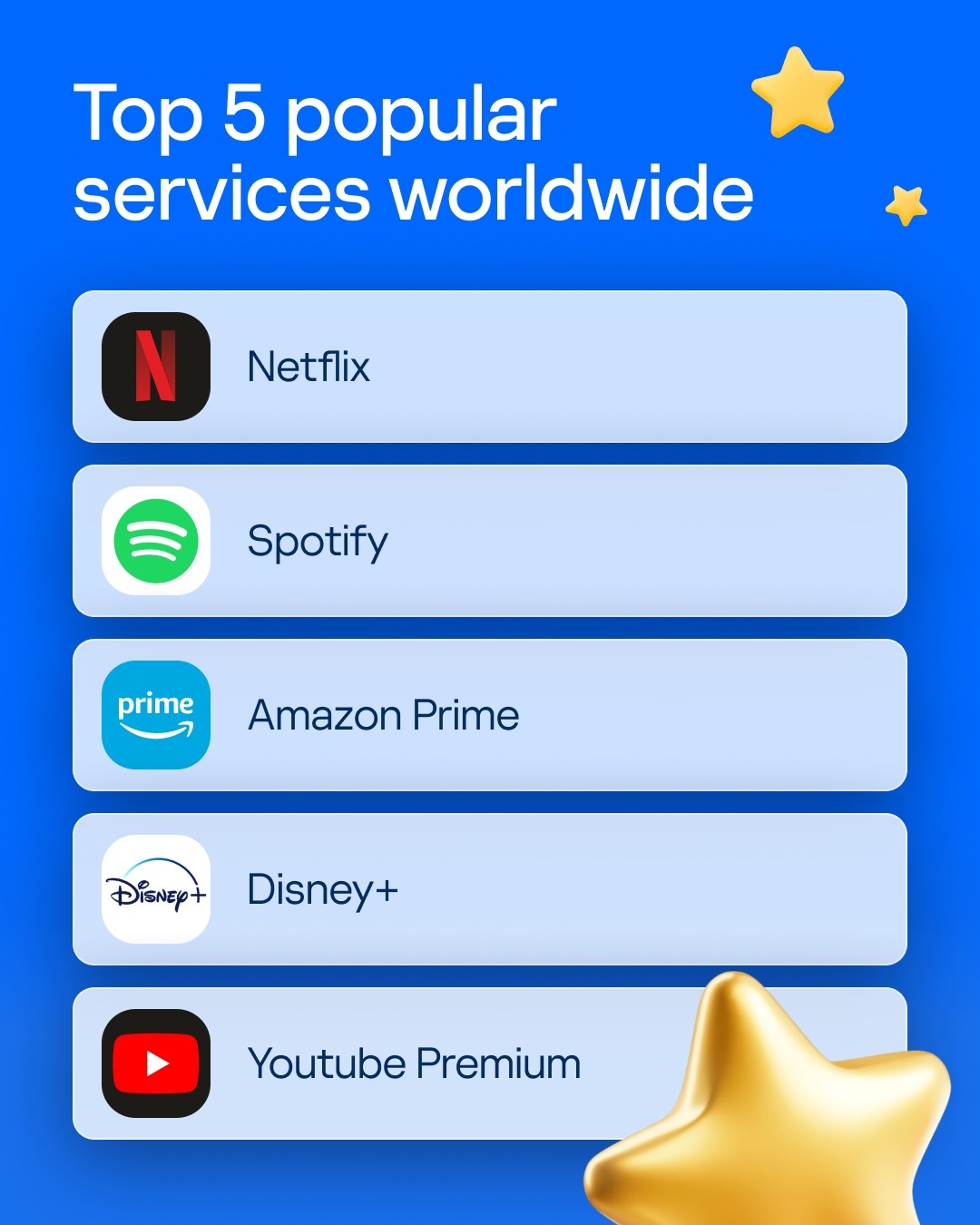Subscriptions are everywhere these days. So much so, it’s becoming increasingly difficult to keep track of them all. More often than not, we drastically — by more than 2.5x! — underestimate how much we spend, because those small recurring charges fly under the radar and don’t add up to a clear picture in our minds. Yet, statistics* show that many users in developed countries spend annually the equivalent of a month’s salary on subscriptions.
Our research* indicates the average subscriber globally spends $938 annually on 12 subscriptions. Leading the pack are US residents — averaging 18 subscriptions totaling $2349 per year. Brazilians, Indians, and Russians average around 10 subscriptions — costing them $732 annually. Turks get the best deal, spending just $478 for 12 subscriptions.
Why such a disparity? The average cost of a single subscription in the US, Germany, and the UK ($12/month) is three times higher than in Russia ($4/month).
The US government has even taken notice of this subscription management conundrum, recently announcing an initiative to simplify canceling unwanted services. But how did these subscriptions come to permeate every aspect of our lives?
The rise of subscription services
Historically, subscriptions have been a niche market since at least the 17th century — when people could pay a monthly fee for regular publications like newspapers, magazines, or book collection volumes. Even daily milk delivery — common in some countries since the mid-19th century — could be considered a subscription of sorts.
Cable television — offering hundreds of channels packed with movies, series and shows — reigned supreme as the most popular subscription of the late 20th century. When Netflix arrived, it didn’t need to reinvent the wheel — the audience was already primed.
Dollar Shave Club pioneered applying this business model to everyday goods. Since 2011, it’s delivered monthly shaving kits at prices significantly lower than retail. The company received 12,000 orders within the first 48 hours of its launch.
Over the past decade, subscriptions have expanded to encompass practically everything — from weekly meal kits and daily fresh socks to… monthly deliveries of real animal bones for collectors and accessories for backyard chicken farmers.

Among the strangest subscriptions are cooking kits with recipes and vinyl records, and even houseplants — delivered monthly
Subscriptions weren’t initially popular in the software world. Most applications were sold in beautiful boxes, on floppy disks or CDs, requiring a hefty one-off payment. But once purchased, you could use the application indefinitely. The few exceptions to this rule were applications needing frequent updates, such as antivirus software, which adopted the subscription model back in the 1990s.
Subscriptions began to penetrate the software sphere with the rise of cloud services, which store user data on the providers’ servers: Dropbox, web hosting, and so on. Here, recurring payments made sense. However, software companies then realized that recurring payments ultimately generate more revenue than one-time purchases. As a result, they started shoehorning the subscription model onto services that didn’t inherently require regular updates or ongoing vendor involvement. Today, you can subscribe to traditionally “boxed” products like office suites, as well as gaming services, music services, and much more. There are even blatantly exploitative offers like a subscription-based calculator.
“Multi-subscriptions” bundling various services under a single payment are gaining traction. Sometimes these services are at least related — like Microsoft 360, but there are also more complex hybrids like Amazon Prime, which combines free shipping, movies, music, games, discounts on groceries, fuel, medications, and much more. Seemingly convenient, it makes evaluating and managing these subscriptions even more complex.
The number of subscriptions per person will likely continue to rise as the vast majority of new software products are released exclusively under a subscription model. Subscription prices are also steadily increasing — over the past two years, the cost of some subscriptions has increased by nearly a third. That’s why subscriptions need to be monitored carefully.
Why managing subscriptions is difficult
With subscriptions so ubiquitous, managing them becomes another basic healthy habit akin to daily exercise or meticulously tracking finances. Not everyone is up to the task. Several technical and psychological factors make it easier to let subscriptions run wild than to actively manage them.
Forgetting to unsubscribe. The very thing that attracts app and service creators to subscriptions is a drawback for customers. It’s not often that people decisively tell themselves, “I’m done with this service!” They typically just use it less and less, eventually forgetting about it for months. Meanwhile, the charges continue. According to various sources, users spend from £39 to $133 monthly on unused subscriptions.
Accumulated data. Migrating data accumulated within a service can be a major hassle. Even after deciding to unsubscribe, people continue paying to avoid losing their data. Sometimes the need for migration dawns just days before renewal, leading users to pay for another year just to buy time for data export.
Duplicate features. For example, subscribing to both Microsoft 365 and Dropbox essentially results in paying twice for cloud storage, as Microsoft 365 includes a direct alternative to Dropbox called OneDrive.
Duplicate subscriptions. Confusing interfaces or poor communication between family members can lead to multiple subscriptions for the same service. Different devices may have different accounts for the same service — each incurring separate charges.
Difficult cancellation process. Some services make unsubscribing incredibly complicated, so frustrated users keep putting it off. As a result, subscriptions can linger around for months or even years, completely unused — but paid for. That’s why the US government decided to step in to streamline cancellation, requiring companies to make it just as simple as subscribing and to make contacting a live support agent easier.
How to get your subscriptions under control
One way to organize your digital life in a subscription-driven world is to cultivate the good habit of diligently documenting your household’s subscriptions as soon as they’re activated and periodically making sure they’re still in use. Even more critical is analyzing every service before subscribing. Will you really be using it regularly? Is pay-as-you-go, or even better, a one-time purchase available? Service and app providers tend to loudly advertise subscription options on their websites while burying alternative payment options like one-time purchases. If you can’t find them, a site-specific Google search may help — just be sure you’re purchasing legitimate software from the official website and not malware from a fake site.
When it comes to “subscription accounting”, the dedicated subscription management service SubsCrab can help. It keeps track of all your subscriptions and sends advance notifications about upcoming payments and subscription expirations. The hardest (and most tedious) part of keeping track of subscriptions is recording them immediately, but SubsCrab can help with this, too. You can connect it to your mailbox, and in some countries to incoming bank statements, and it will automatically scan these sources to detect new subscriptions. This way, all your services will gradually be accounted for, including forgotten ones — and unexpected bank charges reduced. Additionally, SubsCrab lets you manually add other recurring payments, like a mortgage. For more details on the features and settings of SubsCrab, check our review.
Make sure to let your family members know about the new system, and regularly review your subscriptions to cancel those that are no longer needed. Before renewing a subscription, be sure to check the SubsCrab app — it tracks special offers and promo codes, helping you make significant savings on renewals.
* Statistics are based on anonymized data from SubsCrab users (over 150,000 users worldwide, excluding China, from January 2023 to August 2024). This may not reflect the entire market but is representative of a certain audience of users who actively track their subscriptions.
 subscriptions
subscriptions



 Tips
Tips